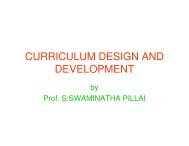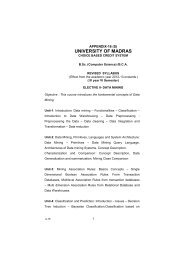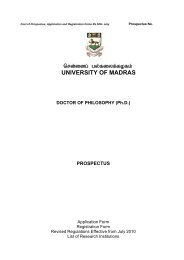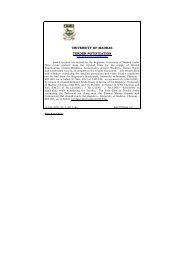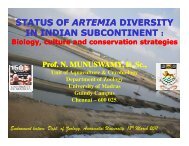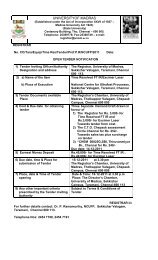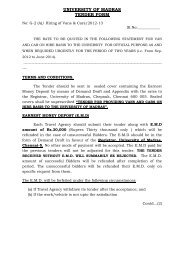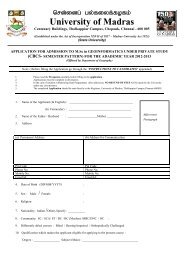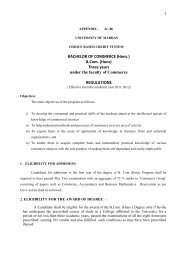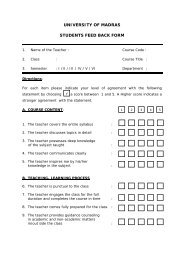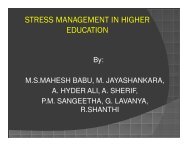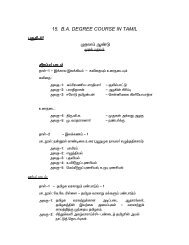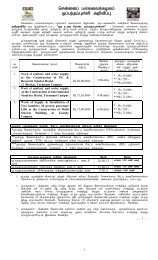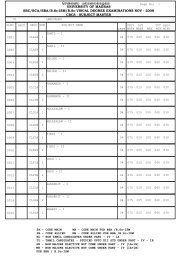M.Com.(ENTREPRENEURSHIP) - University of Madras
M.Com.(ENTREPRENEURSHIP) - University of Madras
M.Com.(ENTREPRENEURSHIP) - University of Madras
Create successful ePaper yourself
Turn your PDF publications into a flip-book with our unique Google optimized e-Paper software.
Appendix – 57(R)<br />
UNIVERSITY OF MADRAS<br />
M.COM. DEGREE COURSE IN <strong>ENTREPRENEURSHIP</strong><br />
CHOICE BASED CREDIT SYSTEM<br />
REGULATIONS<br />
(w.e.f. 2007-2008)<br />
1. Condition for admission:<br />
A candidate who has passed the B.<strong>Com</strong>. B.<strong>Com</strong>/B.A (Corporate Secretaryship), B.<strong>Com</strong> (Acc<br />
Fin) B.C.S., B.B.A., B.<strong>Com</strong> (Bank Management), B.A.(Co-operation), B.A. (Indus. Org.) and<br />
B.Sc.(Maths)/ Bsc (Stats) or B.Sc,(<strong>Com</strong>p. Sc.) or B.C.A, with any two core/main papers <strong>of</strong>fered<br />
at the B.<strong>Com</strong>.<br />
2. ELIGIBILITY FOR THE AWARD OF DEGREE:<br />
A candidate shall be eligible for the award <strong>of</strong> the degree only if he/she has undergone the<br />
prescribed course <strong>of</strong> study in a college affiliated to the <strong>University</strong> for a period <strong>of</strong> not less than<br />
two academic years, passed the examination <strong>of</strong> all the four semesters prescribed earning 72<br />
credits.<br />
3. Duration <strong>of</strong> the course<br />
The course for the Degree <strong>of</strong> Master <strong>of</strong> <strong>Com</strong>merce in Entrepreneurship shall consist <strong>of</strong> two<br />
academic years with four semester.<br />
4. EXAMINATION:<br />
There shall be four examinations, first semester examination at the middle <strong>of</strong> the first<br />
academic year and the second semester examination at the end <strong>of</strong> the first academic year.<br />
Similarly the third and fourth semester examinations will be held at the middle and the end <strong>of</strong> the<br />
second academic year respectively.<br />
5. Course <strong>of</strong> study and scheme <strong>of</strong> examination:<br />
aaaa 1
FIRST SEMESTER<br />
MAX<br />
S. NO.<br />
COURSE<br />
COMPONENTS<br />
NAME OF COURSE<br />
SEMESTER<br />
INST. HOURS<br />
CREDITS<br />
HRS<br />
MARKS<br />
CIA<br />
EXTERNAL<br />
S. NO.<br />
1. CORE EDP 601 Fundamentals <strong>of</strong><br />
Entrepreneurship<br />
1 6 HRS 4 3 20 80<br />
2. CORE EDP 603 Entrepreneurship<br />
Training and Development<br />
1 6 HRS 4 3 20 80<br />
3. CORE EDP 605 Marketing 1 6 HRS 4 3 20 80<br />
4. CORE EDP 607 Financing for<br />
Small Business<br />
5. CORE EDP 609 Cost Estimation<br />
and Control<br />
COURSE<br />
COMPONENTS<br />
SECOND SEMESTER<br />
NAME OF COURSE<br />
6. CORE EDP 602 Business<br />
Regulations<br />
7. CORE EDP 604 Leadership and<br />
Decision Making<br />
8. CORE EDP 606 Production<br />
9.<br />
10.<br />
ELECTIVE I<br />
WITHIN THE<br />
DEPARTMENT<br />
EXTRA<br />
DISCIPLINARY<br />
ELECTIVE II<br />
Planning and Control<br />
SEMESTER<br />
1 6 HRS 4 3 20 80<br />
1 6 HRS 4 3 20 80<br />
INST. HOURS<br />
CREDITS<br />
HRS<br />
MAX<br />
MARKS<br />
CIA<br />
EXTERNAL<br />
II 6 HRS 4 3 20 80<br />
II 6 HRS 4 3 20 80<br />
II 6 HRS 4 3 20 80<br />
II<br />
II<br />
6 HRS 3 3 20 80<br />
6 HRS 3 3 20 80<br />
aaaa 2
THIRD SEMESTER<br />
S. NO.<br />
COURSE<br />
COMPONENTS<br />
NAME OF COURSE<br />
11. CORE EDP 611 Small<br />
Business Promotion<br />
12. CORE EDP 613 Innovation and<br />
Creativity<br />
13. CORE EDP 615 Business<br />
14.<br />
15.<br />
ELECTIVE III<br />
WITHIN THE<br />
DEPARTMENT<br />
EXTRA<br />
DISCIPLINARY<br />
ELECTIVE IV<br />
Taxation<br />
SEMESTER<br />
INST. HOURS<br />
CREDITS<br />
HRS<br />
MAX<br />
MARKS<br />
CIA<br />
EXTERNAL<br />
III 6 HRS 4 3 20 80<br />
III 6 HRS 4 3 20 80<br />
III 6 HRS 4 3 20 80<br />
III 6 HRS 3 3 20 80<br />
III 6 HRS 3 3 20 80<br />
aaaa 3
FOURTH SEMESTER<br />
MAX MARKS<br />
S. NO.<br />
COURSE<br />
COMPONENTS<br />
NAME OF COURSE<br />
SEMESTER<br />
INST. HOURS<br />
CREDITS<br />
HRS<br />
CIA<br />
EXTERNAL<br />
16. CORE EDP 610 Research IV 6 HRS 4 3 20 80<br />
Methodology<br />
17. ELECTIVE V IV 6 HRS 3 3 20 80<br />
18. ELECTIVE VI IV 6 HRS 3 3 20 80<br />
19.<br />
19<br />
&<br />
20<br />
PROJECT PLUS<br />
VIVA VOCE<br />
In lieu <strong>of</strong> Project<br />
19 - 20<br />
EDP 612 IV 6 -<br />
EDP 614 <strong>Com</strong>puterized<br />
Accounting<br />
EDP 616 Human<br />
Resource Management<br />
3<br />
3<br />
3<br />
3<br />
150 Project *<br />
50 Viva Voce<br />
(Viva – fully<br />
external)<br />
20<br />
20<br />
80<br />
80<br />
.<br />
aaaa 4
* Project Internal – 50 Marks<br />
External – 100 Marks<br />
ELECTIVES<br />
1. EDP 618 Working Capital Management<br />
2. EDP 619 <strong>Com</strong>puter Applications in Business<br />
3. EDP 620 Management Information System<br />
4. EDP 621 Investment management<br />
5. EDP 622 Quantitative Methods for Business<br />
6. EDP 623 Rural marketing<br />
7. EDP 624 Sickness and Turn around Strategies<br />
8. EDP 626 E-<strong>Com</strong>merce<br />
9. EDP 628 Financial Planning<br />
10. EDP 629 Project Appraisal and Management<br />
11. EDP 630 Foreign Trade<br />
MAY BE OFFERED AS EXTRA DISCIPLINARY COURSES<br />
12. EDP 625 Customer Relationship Management<br />
13. EDP 627 Total Quality Management<br />
14. EDP 631 Business Ethics and Social Responsibility<br />
54 Credits to secure from Core Papers in all the four semesters including Project Work.<br />
Minimum total credits 72 credits for securing a Post - graduate degree in a given subject.<br />
6. Requirements for proceeding to subsequent semester:<br />
i. Candidates shall register their names for the First Semester Examination after the admission in<br />
the PG Courses.<br />
ii. Candidates shall be permitted to proceed from, the First Semester upto Final Semester<br />
irrespective <strong>of</strong> their failure in any <strong>of</strong> the Semester Examination subject to the condition that the<br />
candidates should register for all the arrears subjects <strong>of</strong> earlier semester along with current<br />
(subsequent) Semester subjects.<br />
iii. Candidates shall be eligible to go to subsequent semester, only if they earn, sufficient<br />
attendance as prescribed therefore by the Syndicate from time to time.<br />
iv. Provided in case <strong>of</strong> candidate earning less than 50% <strong>of</strong> attendance in anyone <strong>of</strong> the Semesters<br />
due to any extraordinary circumstance such as medical grounds. Such candidates, who shall<br />
produce Medical Certificate certified by the Principal <strong>of</strong> the College, shall be permitted to<br />
proceed to the next semester and to complete the course <strong>of</strong> study. Such candidate shall have to<br />
aaaa 5
epeat the missed semester by rejoining after completion <strong>of</strong> final semester <strong>of</strong> the course, after<br />
paying the fee for the break <strong>of</strong> study as prescribed by the <strong>University</strong> from time to time.<br />
7. Passing Minimum:<br />
A candidate who has secured a minimum <strong>of</strong> 50 marks in all the papers prescribed and earned a<br />
minimum <strong>of</strong>72 credits will be considered to have passed the masters degree. Candidates who do<br />
not obtain the required minimum marks for a pass in a paper( s )/ project shall be required to<br />
appear for and pass the same at a subsequent appearance.<br />
8. Classification <strong>of</strong> Successful Candidates:<br />
Candidates who secured not less than 60% <strong>of</strong> the aggregate marks in the whole examination shall<br />
be declared to have passed the examination in the First Class.<br />
All other successful candidates shall be declared to have passed in Second Class.<br />
Candidates who obtain 75% <strong>of</strong> the marks in the aggregate shall be deemed to have passed the<br />
examination in First Class with Distinction provided they pass all the examinations prescribed<br />
for the course in the first appearance.<br />
9. GRADING SYSTEM:<br />
The term grading system indicates a Seven (7) Point Scale <strong>of</strong> evaluation <strong>of</strong> the<br />
performances <strong>of</strong> students in terms <strong>of</strong> marks obtained in the CIA and External<br />
Examination, grade points and letter grade.<br />
SEVEN POINT SCALE (As per UGC notification 1998)<br />
GRADE GRADE POINT PERCENTAGE<br />
EQUIVALENT<br />
`O’ = Outstanding 5.50 – 6.00 75 – 100<br />
`A’ = Very Good 4.50 – 5.49 65 – 74<br />
`B’ = Good 3.50 – 4.49 55 – 64<br />
`C’ = Average 3.00 – 3.49 50 – 54<br />
`D’ = Below Average 1.50 – 2.99 35 – 49<br />
`E’ = Poor 0.50 – 1.49 25 – 34<br />
`F’ = Fail 0.00 – 0.49 0 - 24<br />
10. Ranking:<br />
Candidates who pass all the examinations prescribed for the Course in the FIRST<br />
APPEARANCE ITSELF ALONE are eligible for Classification/Ranking/Distinction :<br />
Provided in the case <strong>of</strong> Candidates who pass all the examinations prescribed for the Course with<br />
a break in First Appearance due to the reasons as furnished in the Regulations under<br />
REQUIREMENTS FOR PROCEEDING TO SUBSEQUENT. SEMESTER are only eligible for<br />
Classification/Distinction.<br />
aaaa 6
11. PATTERN OF QUESTION PAPER<br />
Part A (7×2 = 14)<br />
7 out <strong>of</strong> 10 questions (Each requiring 2 to 3 lines <strong>of</strong> answer or 30 words) (2 questions from<br />
each unit)<br />
Part B (5×6 = 30)<br />
5 either or type questions (Each requiring 2 to 3 pages answer or 500 words) (1 from each<br />
unit)<br />
Part C (3×12 = 36)<br />
3 out <strong>of</strong> 5 questions (Each requiring 4 to 5 pages answer or 1200 words) (1 from each unit)<br />
Proportion <strong>of</strong> marks for problems in problem oriented papers are given under the syllabus for the<br />
respective papers.<br />
12. APPEARANCE FOR IMPROVEMENT:<br />
Candidates who have passed in a theory paper / papers are allowed to appear again for<br />
theory paper / papers only once in order to improve his/her marks, by paying the fee prescribed<br />
from time to time. Such candidates are allowed to improve within a maximum period <strong>of</strong> 10<br />
semesters counting from his/her first semester <strong>of</strong> his/her admission. If candidate improve his<br />
marks, then his improved marks will be taken into consideration for the award <strong>of</strong> Classification<br />
only. Such improved marks will not be counted for the award <strong>of</strong> Prizes / Medals, Rank and<br />
Distinction. If the candidate does not show improvement in the marks, his previous marks will<br />
be taken into consideration.<br />
No candidate will be allowed to improve marks in the Practicals, Mini Project, Vivavoce,<br />
Field work.<br />
13.Transitory Provision:<br />
Candidates who have undergone the course <strong>of</strong> study prior to the academic year 2007-2008<br />
will be permitted to appear for the examinations under those Regulations for a period <strong>of</strong> three<br />
years i.e., upto and inclusive <strong>of</strong> April/May 2011 Examinations. Thereafter they will be permitted<br />
to appear for the examinations only under the Regulations then in force.<br />
GUIDELINES FOR INTERNAL ASSESSMENT PROJECT WORK<br />
Work Load for Project work is 12 hours per week. Internal assessment for project work is to<br />
be carried out by the Departmental <strong>Com</strong>mittee with HOD as the Chair Person and all project<br />
Guides as members. They should assess each candidate based on two presentations. Each<br />
candidate should present two seminars. The first one after one month <strong>of</strong> commencement <strong>of</strong><br />
the Project Work where in the proposal for the project work and review <strong>of</strong> literature should<br />
be presented. The second seminar should be presented before submission <strong>of</strong> the Project<br />
Report. The second presentation should cover the results <strong>of</strong> project Work. For each<br />
presentation 25 marks shall be allotted.<br />
At the option <strong>of</strong> the college, the students shall be asked to under go Institutional training for 4<br />
weeks during summer vacation immediately after first year. If such arrangement is made, the<br />
candidate shall be asked to make a presentation in the first week <strong>of</strong> 4 th semester on the<br />
training programme undergone and the experience gained. 20 marks may be allotted for this<br />
aaaa 7
presentation. Where ever Institutional training is encouraged, the project related seminars<br />
shall carry 15 marks each.<br />
GUIDELINES FOR CONTINUOUS INTERNAL ASSESSMENT<br />
In case <strong>of</strong> internal assessment for other papers, each faculty member should conduct a<br />
minimum <strong>of</strong> two tests and the students should write atleast one assignment and present one<br />
seminar in the subject taught by the faculty member. The marks may be allotted to each<br />
component and the total internal assessment marks obtained by each student may be<br />
recorded. Each faculty member and the Department should maintain a record <strong>of</strong> the details <strong>of</strong><br />
internal assessment marks awarded to each student.<br />
Each year in the beginning <strong>of</strong> the 4 th semester the Head <strong>of</strong> Department and the faculty<br />
members who are involved in the project guidance should prepare a list <strong>of</strong> topics for project<br />
work and the students should be asked to choose from the list. Each student should work on a<br />
different topic.<br />
The viva voce for each candidate shall be conducted by the external examiner appointed by<br />
the <strong>University</strong>.<br />
INSTRUCTIONS for COURSE TRANSACTIONS<br />
Out <strong>of</strong> the total teaching hours allotted to each paper, the departmental committee may<br />
allocate needed number <strong>of</strong> hours to the following:<br />
Practicals<br />
Library work<br />
Seminars<br />
Tutorials<br />
Quiz<br />
Field Work<br />
Institutional visits<br />
ACF 07<br />
aaaa 8
Appendix – 57(S)<br />
UNIVERSITY OF MADRAS<br />
M.COM. DEGREE COURSE IN<br />
<strong>ENTREPRENEURSHIP</strong><br />
CHOICE BASED CREDIT SYSTEM<br />
SYLLABUS<br />
(w.e.f. 2007-2008)<br />
SEMESTER – I<br />
EDP 601 FUNDAMENTALS OF <strong>ENTREPRENEURSHIP</strong> ( Credits –4)<br />
OBJECTIVES<br />
1. Impart knowledge about concepts <strong>of</strong> entrepreneurship and its function<br />
2. Familiarize with the theories <strong>of</strong> entrepreneurship<br />
3. Discuss the Business planning process<br />
4. Equip to face the barriers to entrepreneurship<br />
5. Analysis the role played by NGOs and SHGs in rural entrepreneurship<br />
Unit – I<br />
Introduction – Concepts <strong>of</strong> entrepreneurship – entrepreneur Vs. Intrapreneur –<br />
entrepreneur Vs. entrepreneurship – Entrepreneurial characteristics and functions –<br />
entrepreneurship culture – Weberian proposition – Culture in non western countries – Culture in<br />
less developed countries.<br />
Unit – II<br />
Theories <strong>of</strong> entrepreneurship- Entrepreneurial traits – types – behavioral patterns – major<br />
competencies – developing competencies. Entrepreneurship mobility – factors influencing<br />
mobility: occupational, locational.<br />
Unit – III<br />
Creating entrepreneurial venture – Business planning process – Environmental analysis –<br />
search and scanning – Identifying problems and opportunities -Sources <strong>of</strong> business ideas –<br />
defining business idea – - Basic Governmental procedures to be complied with –Preliminary<br />
evaluation <strong>of</strong> business idea – Technical, financial, economic, marketing, personnel- Management<br />
feasibility.<br />
aaaa 9
Unit – IV<br />
Environmental issues in entrepreneurship – prospective entrepreneurs in the IT sector and<br />
their perceived problems. Barriers to entrepreneurship – Economical , Non economical, personal<br />
barriers.<br />
Unit – V<br />
Women entrepreneurship – concept, functions, growth, problems, functions,<br />
development. Rural entrepreneurship – meaning – need – problems – how to develop rural<br />
entrepreneurs – Role <strong>of</strong> NGOs and SHGs in rural entrepreneurship.<br />
References:<br />
1. S.S.Khanka , ‘Entrepreneurial development’ , S.Chand, Latest Edition.<br />
2. Brigette Burger , ‘ The culture <strong>of</strong> entrepreneurship’, Tata Mc-Graw Hill, Latest Edition.<br />
3. Dr, Aruna Kaulgad , ‘ Entrepreneurship Management’, Thomson Learning,2003<br />
4. B.S.Rathore & S.K.Dhaneja , ‘ Entrepreneurship in the 21 st Century’, Rawat<br />
Publications,1999<br />
5. David H.Holt , ‘ Entrepreneurship new venture creation’, Prentice Hall India, Latest<br />
Edition.<br />
6. Hisrich Peters , ‘Entrepreneurship’,Tata Mc -Graw Hill, 1998<br />
7. Lalitha Nagarajan, ‘Self help group in rural development’, Dominant Publishers,2002<br />
EDP 603 <strong>ENTREPRENEURSHIP</strong> TRAINING ( Credits –4)<br />
AND DEVELOPMENT<br />
OBJECTIVE<br />
1. Discuss the need for entrepreneurship development programmes<br />
2. Evaluate the factors contributing to the growth<br />
3. In depth analysis into leading small, medium and large scale and service organizations<br />
4. Provide necessary framework to estimate the financial requirements and ways to meet<br />
them<br />
Unit – I<br />
Importance <strong>of</strong> Entrepreneurship in economic development – Factors affecting<br />
entrepreneurial growth: Cultural, social, economic and personality factors- need for<br />
Entrepreneurship development programmes – objectives – phases- identification <strong>of</strong> potential<br />
entrepreneurs – evaluation .<br />
Unit – II<br />
Strategy for devising efficient training mechanism – training – target groups – special<br />
agencies and schemes – Entrepreneurship motivation – theories – Cultural and environmental<br />
aaaa 10
aspects - factors: ambitions, compelling reasons – facilitating factors – motives : self fulfillment,<br />
competence – achievement motivation process.<br />
Unit – III<br />
Agencies for Entrepreneurship development – sources <strong>of</strong> marketing information – Project<br />
development – Salesmanship for entrepreneurs – product selection – process – criteria – ethical<br />
Entrepreneurship – Challenges and rewards.<br />
Unit –I V<br />
Implementation <strong>of</strong> TQM in Entrepreneurship development – Effectiveness <strong>of</strong> support<br />
systems – case studies <strong>of</strong> leading entrepreneurs – small scale, large scale and service<br />
organizations.<br />
Unit V<br />
Estimating and financing Funds requirements – Short term and long term capital-<br />
Agencies providing financial assistance – Relevant schemes <strong>of</strong> DFIs, SFIs, <strong>Com</strong>mercial banks –<br />
Venture capital funds.<br />
References:<br />
1. S.S.Khanka ,’Entrepreneurial development’, S.Chand, 1999<br />
2. David H.Holt – ‘Entrepreneurship new venture creation’ – Prentice Hall India, Latest<br />
Edition.<br />
3. Hisrich Peters,’Entrepreneurship’, Tata Mc- Graw Hill,1998<br />
4. B.S.Rathore & S.K.Dhaneja,‘Entrepreneurship in the 21 st Century’,Rawat<br />
Publications,1999<br />
5. Dr, Aruna Kaulgad , ‘Entrepreneurship Management’, Thomson Learning,2003<br />
6. Satish Taneja, S.L.Gupta, Entrepreneurship Development – New venture creation’,<br />
Galgotia Publishing company, 2001<br />
7. Gupta, C.B., & Srinivasan, N.S., Entrepreneurial Development in India, 5 th edn., Sultan<br />
Chand, Reprint 2004, New Delhi.<br />
aaaa 11
EDP 605 MARKETING ( Credits –4)<br />
OBJECTIVE<br />
1. Know the overview about marketing and its relevance in today’s world<br />
2. Understand the strategies involved in marketing mix decisions viz product, price,<br />
promotion and place<br />
Unit – I<br />
Evolution <strong>of</strong> marketing – The core concepts <strong>of</strong> marketing – Features – Importance <strong>of</strong><br />
modern marketing – Function <strong>of</strong> marketing – Marketing environment – Consumer behavior –<br />
Market segmentation - Marketing strategy.<br />
Unit – II<br />
Product decision – Product mix decision - Product positioning – Product strategies –<br />
Branding and Packaging – Product life cycle – New product planning and Development.<br />
Unit –III<br />
Pricing decision – Pricing objectives, Policies, and Strategies – New product pricing –<br />
Pricing strategies for stages in life cycle <strong>of</strong> product.<br />
Unit – IV<br />
Channel decision – Role <strong>of</strong> distribution channels – Channel functions - Channel<br />
management decision – Factors governing choice <strong>of</strong> channel – Selection <strong>of</strong> channel for new<br />
products.<br />
Unit – V<br />
Promotional decision – The promotion mix – Advertising, Sales promotion,<br />
Personnel selling – Direct marketing – On line marketing –Ethical issues in marketing.<br />
References:<br />
1. Philip Kotler, ‘Marketing Management’, Pearson education inc ,2003<br />
2. Stantan, ‘Fundamentals <strong>of</strong> Marketing’ , Tata Mc Graw hill, Latest Edition.<br />
3. Walker, ‘Marketing Strategy : Planning and Implementation’, Tata Mc Graw Hill.<br />
4. Micheal R. Czinkota & Masaki kotabe, ‘Marketing Mnagement’,Vikas publishing Pvt.<br />
Ltd.<br />
5. V.S.Ramaswamy & S.Namakumari, ‘Marketing Management’,Mac Millan 2004.<br />
6. Nikilesh,Rakesh,Labdhi & Abhinandan, ‘Marketing Management – Cases & Concepts’,<br />
Mac Millan-2004.<br />
7. R.L.Vershney & S.L. Gupta, ‘Maqrketing Management- an Indian Perspective’, Sultan<br />
chand & sons 2000.<br />
aaaa 12
EDP 607 FINANCING FOR SMALL BUSINESS ( Credits –4)<br />
OBJECTIVE<br />
1. Analyze the requirement <strong>of</strong> capital and methods <strong>of</strong> raising<br />
2. Know the role <strong>of</strong> Banks and its credit appraisal<br />
3. Familiarize with the assistance and benefits extended to SSI<br />
Unit – I<br />
Capital requirement <strong>of</strong> small business-Capital structure and long term financing –<br />
Sources –credit facilities –SEBI guidelines for new issues –Promoters contribution –guidelines<br />
for issue <strong>of</strong> debt instruments.<br />
Unit – II<br />
Working capital Financing –Objectives –<strong>Com</strong>position- Role <strong>of</strong> commercial banks –<br />
credit appraisal by banks –Tandon and Chore <strong>Com</strong>mittee recommendations-Borrowings and<br />
public Deposits.<br />
Unit - III<br />
Institutions providing Financial assistance-Loan schemes <strong>of</strong>fered by SIDBI, SIDC’s,<br />
SIIC’s, NSIC and NABARD- Difficulties in procuring Institutional finance.<br />
Unit – IV<br />
Lease financing and Hire purchase finance-Venture capital –Role <strong>of</strong> consultancy<br />
organizations<br />
Unit – V<br />
Taxation benefits to SSI – need for tax benefits – tax holiday – depreciation –<br />
rehabilation allowance – expenditure on scientific research – amortization <strong>of</strong> preliminary<br />
expenses – tax concessions to SSI in rural areas and backward areas – MODVAT and small scale<br />
industries.<br />
References:<br />
1. Longeneckar et al, ‘Small business management’, Southwestern college<br />
publications,1999.<br />
2. S.S Khanka, ‘Entrepreneurial development’ , S.Chand publications,1999.<br />
3. Dansteinsh<strong>of</strong>f JohnA.Burgess, ‘ Small business management fundamentals’, Mc graw<br />
Hill- International,2000.<br />
4. Dr. Mata Badal Shukla , ‘Entrepreneurship and small business management’, Kitab<br />
Mahal publications – Patna, Latest edition.<br />
aaaa 13
5. SIDBI report on SSI sector – SIDBI publications – New Delhi.<br />
8. Ashok.K.Arora, ‘Financing <strong>of</strong> small-scale industries’,Deep & Deep publications Latest<br />
Edition..<br />
6. Vasant Desai , ‘Entrepreneurial development’ ,2000.<br />
EDP 609 COST ESTIMATION AND CONTROL (Credits –4)<br />
OBJECTIVE<br />
Unit-I<br />
1. Acquaint one self about the need for costing and its impact on decision making<br />
2. Familiarize with types <strong>of</strong> costing and its applications<br />
3. Discuss the system <strong>of</strong> control and reduction<br />
Introduction – Cost behaviour and value improvements- Need for cost informationcosting<br />
systems –cost behaviour and decision making –financial gearing and operational gearing.<br />
Unit-II<br />
Systems for product cost determination –concepts in cost determination-activity based<br />
costing and management -job and process costing –applications.<br />
Unit –III<br />
Systems for decision making –Marginal costing and contribution analysis –Differential<br />
costing<br />
Unit –IV<br />
System for cost control and reduction –Budgetary control –Functional budgets and<br />
responsibility system.<br />
Unit – V<br />
Standard costing and variance analysis –Material ,Labour Overhead and pr<strong>of</strong>it variances.<br />
Note- The question paper consist 80% problems and 20% theory questions<br />
References:<br />
1. V.G.Sridharan, “Costing for Management” ,Vikas publishing house<br />
2. S.P.Jain & K.L.Narang, “Advanced cost accounting’ , Kalyani Publishers,2000.<br />
3. David Asch and G. Ronald Kaye, “Financial planning” ,Kogan press.<br />
4. Charles T. Horngren, “Cost Accounting :A managerial emphasis” ;Prentice Hall, New<br />
Delhi, 2004.<br />
aaaa 14
SEMESTER – II<br />
EDP 602 BUSINESS REGULATIONS (Credits –4)<br />
OBJECTIVE<br />
1. Discuss the policies relating to foreign private investment and the role <strong>of</strong> public sector in<br />
the economic development<br />
2. Know the issues relating to the Securities and Exchange Board <strong>of</strong> India Act 1991<br />
3. Know the impact <strong>of</strong> Environment Protection Act, Intellectual Property Rights Act 2002<br />
on decision making<br />
Unit – I<br />
The Legal framework – Industrial policy <strong>of</strong> government <strong>of</strong> India and Policy Relating to<br />
Foreign Private Investment in India – Small Scale Industries – Role <strong>of</strong> Public Sector Industries –<br />
Disinvestments <strong>of</strong> PSUs – The Securities contract (Regulations)Act 1956,Sec. 13 to 22A.<br />
Unit – II<br />
The Securities and Exchange Board <strong>of</strong> India Act 1991 – SEBI Guideline for Capital<br />
Issues – OTCEI – NSEI Organisation and Transactions – Investor Protection – Trade and<br />
Merchandise Marks Act,1956 – Patents Ac,1970.<br />
Unit – III<br />
The environment protection Act, 1986 – Government measures – general powers <strong>of</strong> GOI<br />
– Consumer protection Act, 1986<br />
Unit – IV<br />
The Business Enterprise in the Society – Corporate Social Responsibility – Government<br />
Regulation <strong>of</strong> Business – Privatisation Process in India – Ethics and Values in Business – Social<br />
Accounting – Social Audit.<br />
Unit – V<br />
<strong>Com</strong>petitive Law – Intellectual Property Rights - Information Technology Act,2002 – FEMA<br />
1999 – Important Provisions – Corporate Governance Code – Practices – K.Birla Report – Case<br />
Laws<br />
aaaa 15
References:<br />
1. Kazmi Azhar, “Business Policy”, New Delhi, TMH, 2002.<br />
2. P.K.Ghosh, “Business Policy, Strategic Planning and Management”, Sultan Chand &<br />
Co., New Delhi, 2002.<br />
3. Made Gowda, “Business Environment And Policy” Deep & Deep Publications, 2000.<br />
4. Francis Cherunilam, “Business Environment and Policy”, 2 nd Edn, Oscar Publiations,<br />
2001.<br />
5. Henry A. Tombari, “Business and Society: Strategies for the Environment and Public<br />
Policy”, Dryden Press.<br />
6. William F. Gluek and Lawrence R.Jaach, “Business Policy and Strategic Management,<br />
McGraw Hill, 2001.<br />
7. Corporate Laws, Taxman, 2002.<br />
8. Bare Acts<br />
EDP 604 LEADERSHIP AND DECISION MAKING (Credits –4)<br />
OBJECTIVE<br />
Unit I<br />
1. Understand the meaning, need and role <strong>of</strong> leadership<br />
2. Study the modern theories <strong>of</strong> leadership<br />
3. Know decision making, its techniques and process<br />
4. Gain insight into contemporary challenges in leadership<br />
Leadership: Meaning-Need-The roles and activities <strong>of</strong> Leadership-Types <strong>of</strong> Leaders-<br />
<strong>Com</strong>petencies <strong>of</strong> a Leader.<br />
Unit II<br />
Classic studies and Modern theories <strong>of</strong> Leadership: Trait Theory –Behavioral Theory –<br />
Blake and Mouton Managerial Grid-Fielders Contingency Model-Situational Theory-The Path<br />
Goal Theory- Neo Charismatic Theories <strong>of</strong> Leadership.<br />
Unit III<br />
Decision Making: Conceptual perspectives-Nature-Rational Decision Making process-<br />
The role and importance <strong>of</strong> Intuition in Decision making process-Decision Making Models:<br />
Behavioral Decision making-Strengths and Weaknesses- Decision making Techniques.<br />
aaaa 16
Unit IV<br />
Leadership skills and Types <strong>of</strong> Leadership- Leadership styles - Importance <strong>of</strong> Decision<br />
Making skill on Leadership styles-Decisional styles implication on Classic and the modern<br />
Leadership theories-Decision styles, Leadership and Organizational effectiveness.<br />
Unit V<br />
Contemporary challenges-Trust and Leadership-Cross Cultural Leadership and Decision<br />
Making-Impact <strong>of</strong> Decision Making and Leadership skills on conflict resolution process-<br />
Importance <strong>of</strong> Effective Decision Making and Leadership in the modern workplace.<br />
References:<br />
1. Fred Luthans, “Organisational Behavior”, McGraw Hill, International Edn., 1998<br />
2. Stephen Robbins, “Organisational Behaviour”, McGraw Hill, 2002<br />
3. Maheshwari B.L., “Decision Styles and Organisational Effectiveness”, Vikas Publishing<br />
House, 1981<br />
4. Hugh J Arnold et al, “Organisational Behaviour” McGraw Hill, 2002<br />
5. Arabinda Ray, “The Indian Managers still in search <strong>of</strong> a style”, UBS Publishers, 1997<br />
6. Gill Robinson Hickman (Edited), “Leading Organisations – Perspectives for a new era”,<br />
Sage Publications, 1999<br />
7. Peter G. North House, “Leadership Theory and Practice”, Sage Publications, 2000<br />
8. P.T.Joseph, “The Nine Managerial Styles <strong>of</strong> the Enneagram”, Response Books, 2002<br />
9. Craig E. Johnson, “Meeting the ethical challenges <strong>of</strong> Leadership”, Sage Publications,<br />
2001<br />
10. Peter Drucker, “ Decision Theory, Effective executives”<br />
EDP 606 PRODUCTION, PLANNING & CONTROL (Credits –4)<br />
OBJECTIVE<br />
1. Define products and protection system<br />
2. Know the use <strong>of</strong> various models like GANTT chart, optimal batch sizing etc in process<br />
analysis and programming<br />
3. Understand the various scheduling and sequencing techniques<br />
Unit – I<br />
Definition & meaning <strong>of</strong> products - Nature <strong>of</strong> production functions – production process<br />
– designing a process – general procedures – production systems – types <strong>of</strong> projects – nature &<br />
need <strong>of</strong> a factory production system – jobbing & mass production systems.<br />
aaaa 17
Unit – II<br />
Planning objectives – make or buy decisions – design <strong>of</strong> production planning systems -<br />
process analysis & programming – GANTT chart – optimal batch sizing – aggregate planning<br />
H.M.M.S. Model<br />
Unit – III<br />
Production control & cost control – basic definitions – need for controlling production -<br />
control procedures – the production control functions – setup & organisational placement <strong>of</strong><br />
production control – basic control systems – SHEWHART control charts.<br />
Unit – IV<br />
Linear programming – Waiting Line models - Networks for project cost control -<br />
Scheduling & sequencing techniques - resource analysis – simulation techniques.<br />
Unit – V<br />
Application <strong>of</strong> forecasting techniques – exponential smoothing – time series analysis in<br />
production management- line balancing – Q system – P system - ά lien systems.<br />
Note- The question paper consist 60% theory and 40% problem questions<br />
References:<br />
1. S.Bhattacharya, “ Production planning and control”, Vikas Publishers, 1986<br />
2. Sitarama.L.Narasimham, Dennis W.Mc Leavy, Peter J. Billington, “Production planning<br />
and inventory control”, Prentice Hall India, 2000<br />
3. George W. Plossal, “Production planning”, Prentice Hall India, 1986<br />
4. E.H.Macniece, “Production forecasting, planning and control”, John Wiley, 1961<br />
5. Buffa, Modern Production /Operations Management, 7 th edition, Wiley Eastern Ltd.<br />
6. Mohanty R P, A textbook <strong>of</strong> Works Management, AIMA VIKAS Management Series,<br />
Vani Education Books<br />
7. Ahuja, K. K. , Production Management, CBS Publishing<br />
8. Elwood S Buffa, Modern Production Management, 2 nd edition, John Wiley & Sons<br />
9. Alan Muhlemann, John Oakland & Keith Lockyer, Production & Operations<br />
Management, 6 th edition, MacMillan<br />
10. Narasimhan, Mcleavey & Billington, Production Planning & Inventory Control, 2 nd<br />
edition, Prentice Hall <strong>of</strong> India Pvt. Ltd., New Delhi<br />
aaaa 18
SEMESTER – III<br />
EDP 611 SMALL BUSINESS PROMOTION (Credits –4)<br />
OBJECTIVE<br />
1. Define the importance <strong>of</strong> small business organization<br />
2. Know the market survey and opportunity for small business<br />
3. Identify a feasible location<br />
4. Learn the intellectual property and the entrepreneurship patents<br />
5. Study the small entrepreneurship in international business<br />
Unit I<br />
Definition- Importance- Opportunities for an Entrepreneurial Career-Forms <strong>of</strong> Small<br />
Business Organizations-SSI Registration benefits – Subsidies and Incentives – Export<br />
possibilities.<br />
Unit II<br />
Market survey and Opportunity-Business planning- start up strategies for Small<br />
Business. Preparation <strong>of</strong> the parts <strong>of</strong> the Business plan: Choosing a product or service-Criteria-<br />
Evaluating an existing business-Buyout Vs. New Venture Decisions-Understanding the legalities<br />
<strong>of</strong> Buyouts-Government Regulation and necessary paper work for Business start -ups.<br />
Unit III<br />
Identification <strong>of</strong> a feasible location-Importance <strong>of</strong> location for small business-marketing<br />
research for site selection-Locating a manufacturing plant-Site criteria used by the high-<br />
Technology companies-the influence role <strong>of</strong>f Industrial parks.<br />
Unit IV<br />
Intellectual property and the Entrepreneur- Patents- Patent process- Copyrights-<br />
Trademarks. Support systems-District Industry centers, SFC’s, SISI, NABARD, National Small<br />
Industries Corporation and other relevant institutions/organizations at the state level.<br />
Unit V<br />
Small Enterprise in International Business- Export potentials <strong>of</strong> small units- Major<br />
constraints - Strategies for growth in Small Business-Managing growth and Transition.<br />
aaaa 19
References:<br />
1. Colin Barrow, “The Essence <strong>of</strong> Small Business”, Prentice Hall, 1993<br />
2. Joseph R. Manauso, “How to start, finance and manage your small business”, Prentice<br />
Hall<br />
3. C.B.Gupta & N.P.Srinivasan, “Entrepreneurship Development” Sultan Chand & Sons,<br />
1992<br />
4. David H. Holt, “Entreprenuership – New Venture Creation”, Prentice Hall, 1992<br />
5. K.C.Nanda, “Credit and Banking”, Response Books, 1999<br />
6. S.S.Khanka, “Entrepreneurial Development”, Sultan Chand & Sons, 1999<br />
7. Nicholas Siropolis, “Entrepreneurship and Small Business Management”, Houghton<br />
Mifflin Co., 1998<br />
8. Justin G. Longecker et al, “Small Business Management”, South Western College<br />
Publication, 1999<br />
EDP 613 INNOVATION AND CREATIVITY (Credits –4)<br />
OBJECTIVE<br />
1. Know what creativity and innovation is, dimensions <strong>of</strong> innovation and the innovation<br />
arena<br />
2. Learn about the searching and selecting <strong>of</strong> business idea<br />
3. Study the various creativity enhancing methods<br />
4. Analyze the NPD and NBD processes, innovation networks and supply chain<br />
Unit – I<br />
Creativity and innovation – meaning – Process – <strong>Com</strong>ponents: Intrinsic motivation, Task<br />
skills, creative thinking. Creative Enterprises – Innovation and entrepreneurship linkage –<br />
Dimensions <strong>of</strong> innovation and the innovation arena.<br />
Unit – II<br />
Searching and selecting business ideas – methods <strong>of</strong> generating new ideas – dynamics <strong>of</strong><br />
project identification – matching products and entrepreneurs.<br />
Unit – III<br />
Creativity enhancement methods – Brainstorming, Lateral thinking, mind mapping,<br />
random stimulation. New product development and new business development – Co – evolution<br />
<strong>of</strong> technology – products, markets and organizations.<br />
aaaa 20
Unit – IV<br />
The innovation arena and technical business systems – Analysis <strong>of</strong> external position and<br />
internal analysis <strong>of</strong> resources and assets. Internal and external stakeholders – predicting<br />
stakeholders’ behavior and its effects on NPD and NBD processes.<br />
Unit – V<br />
Analysis <strong>of</strong> NPD and NBD – non-linear mechanisms – computer modeling – validation<br />
and calibration <strong>of</strong> the model – sensitivity analysis. Benchmarking – Improving internal processes<br />
and extra-company processes. Innovation strategies – Innovation networks and supply chains.<br />
References:<br />
1. Felix Janson , Age <strong>of</strong> Innovation , Prentice Hall India, 2000<br />
2. Jacob Goldenberg, Creativity in product Innovation , Cambridge <strong>University</strong> Press,2002<br />
3. Tom Burns & G.M.Stalker, The management <strong>of</strong> Innovation – Oxford,Dec 2000<br />
4. Satish Taneja, S.L.Gupta, Entrepreneurship Development – New venture creation ,<br />
Galgotia Publishing company,1999<br />
5. Nino S.Levy, Managing High technology and Innovation , Prentice Hall,1998<br />
6. V.K.Narayanan, “Managing Technology and innovation for competitive advantage”,<br />
Prentice Hall India,2001<br />
7. Shirur.S.Sherwani, “ Creativity in management”, Deep & Deep Publications, 2004<br />
8. Drucker, “Innovation and Entrepreneurship”, Harper and Row Publishers, 1997.<br />
9. Jane Henry, “Creativity and Perception in Management”,Sage Publications,2001.<br />
EDP 615 BUSINESS TAXATION (Credits –4)<br />
OBJECTIVE<br />
1. To know about custom duty, <strong>of</strong>ficers <strong>of</strong> the custom, powers, <strong>of</strong>fences and penalties<br />
2. To understand the mail for import for re export, export rebates, duty free zones<br />
3. To know about the refund <strong>of</strong> duty on inputs for production <strong>of</strong> other goods<br />
4. To find out the rates <strong>of</strong> tax, levy, collection <strong>of</strong> tax, registration <strong>of</strong> dealer etc<br />
5. Keeping <strong>of</strong> accounting for purpose <strong>of</strong> sales tax<br />
Unit – I<br />
Customs Duty – codes – Tariffs – Organization <strong>of</strong> the Customs department – Officers <strong>of</strong><br />
the Customs – Powers – Levy <strong>of</strong> duty – Appellate machinery – Infringement <strong>of</strong> Law – Offences<br />
& Penalties – settlement <strong>of</strong> disputes.<br />
aaaa 21
Unit – II<br />
Baggage – Mail – Imports for re export – Re –imports – Project imports – deferment <strong>of</strong><br />
Levy – warehousing – export rebates and duty drawback – duty free zones – inputs.<br />
Unit – III<br />
Central excise duty – basis <strong>of</strong> levy – excise administration – refund <strong>of</strong> duty on inputs for<br />
production <strong>of</strong> other goods- use under bond – Captive Consumption – Set <strong>of</strong>f Pr<strong>of</strong>orma Credit and<br />
MODVAT – smallscale industries – concessions – <strong>Com</strong>pounded Levy<br />
Unit – IV<br />
Central Sales Tax – Concept <strong>of</strong> sale and purchase – inter state import & export trade or<br />
commerce – Registration <strong>of</strong> dealers – rates <strong>of</strong> tax – determination <strong>of</strong> turnover – Levy &<br />
Collection <strong>of</strong> tax – Penalties & cognizance <strong>of</strong> <strong>of</strong>fences – Goods <strong>of</strong> special importance –<br />
Liabilities in special cases<br />
Unit – V<br />
TNGST – Definition <strong>of</strong> sale – taxable turnover – dealer – single point; multipoint –<br />
Registration <strong>of</strong> dealer – Cancellation <strong>of</strong> registration – filing <strong>of</strong> periodical returns –payment <strong>of</strong> tax<br />
at regular intervals and on demand- Assesment procedure – appeals – revisions & references –<br />
keeping <strong>of</strong> accounts for purposes <strong>of</strong> sales tax<br />
Note- The question paper should consist 40% problems and 60% theory questions.<br />
References :<br />
1. Customs Act,1952<br />
2. Central Excise & Salt Act, 1944<br />
3. Central sales tax Act<br />
4. TNGST Act<br />
5. V.S. Datey, Indirect taxes, Taxmann, New Delhi<br />
6. V. Balachandran, indirect taxes – New Delhi, Sultan Chand<br />
7. N.S. Govindan, Indirect taxes, Sitaraman & Co, Chennai 2003.<br />
aaaa 22
SEMESTER – IV<br />
EDP 610 RESEARCH METHODOLOGY (Credits –4)<br />
OBJECTIVE<br />
1. To study about the steps in selection and formulation <strong>of</strong> research problems<br />
2. To formulate hypothesis, sampling techniques and sampling error and sampling size<br />
3. To know about the various methods <strong>of</strong> data collection, testing validity and reliability<br />
4. To understand the contents <strong>of</strong> a report and types <strong>of</strong> report<br />
5. To know the steps involved in drafting a report<br />
Unit – I<br />
Research – meaning & purpose – types <strong>of</strong> research – pure and applied, survey, case study<br />
– experimental, exploratory - Research design – steps in selection & formulation <strong>of</strong> a research<br />
problem – steps in research - review <strong>of</strong> literature.<br />
Unit – II<br />
Formulation <strong>of</strong> hypothesis – types, sources – testing – sampling techniques – sampling<br />
error & sample size.<br />
Unit – III<br />
Methods <strong>of</strong> data collection – primary & secondary data – observation – interview –<br />
questionnaire – construction <strong>of</strong> tools for data collection – Testing validity and reliability – Pilot<br />
study and Pre–testing.<br />
Unit - IV<br />
Processing & analysis <strong>of</strong> data – editing – coding – transcription - tabulation – outline <strong>of</strong><br />
statistical analysis – descriptive statistics – elements <strong>of</strong> processing through computers – packages<br />
for analysis.<br />
Unit – V<br />
Report writing – target audience – types <strong>of</strong> reports – contents <strong>of</strong> a report – style and<br />
conventions in reporting – steps in drafting a report.<br />
References:<br />
1. William C. Emory, Business Research Methods, R.D. Irwin Inc.<br />
2. Robert G. Murdick, Business Research: Concepts & Practice, International Text Book<br />
<strong>Com</strong>pany<br />
aaaa 23
3. Claus Moser & Graham Kalton, Survey Methods in Social Investigation, Gower<br />
Publishing Co.<br />
4. Anderson J. Berry H.D. & Poole M., Thesis & Assignment Writing, Wiley Eastern<br />
Ltd.<br />
5. Kothari C R, Research Methodology, Vikas Publishing Ltd.2002<br />
6. Krishnasamy O R, Research Methodology,Himalaya publishing house,1998<br />
7. Cooper, “Business research Methods”, Tata Mc Graw Hill, 2000<br />
EDP 614 COMPUTERISED ACCOUNTING (Credits –3)<br />
OBJECTIVE<br />
1. To know about the basic concept <strong>of</strong> computerized accounting and inventory system<br />
2. To create accounting master – ledger, accounting voucher, stock transfer and physical<br />
stock voucher<br />
3. To learn how to prepare reports, trial balance, balance sheet, inventory report, report to<br />
file and report on printer<br />
Practices<br />
4. Configuring ads setting up preparation<br />
5. Masters <strong>of</strong> transactions and report<br />
6. Maintenance <strong>of</strong> house keeping, restore and reconciliation<br />
Unit – I<br />
Introduction – features – basic concept <strong>of</strong> <strong>Com</strong>puterized accounting and Inventory<br />
system – accounts organisation & types <strong>of</strong> accounts – accounts statements – purchases & sales –<br />
credit & debit – transaction, invoice, voucher, order, cost & stock – income & expenses –<br />
inventory control.<br />
Unit – II<br />
Masters – creation <strong>of</strong> Accounts Master – Ledger – cost – group – Budgets – Voucher &<br />
Currencies Inventory – creation <strong>of</strong> Inventory Master – Stock Item – Group & Unit measurement.<br />
Unit – III<br />
Transactions – Accounts vouchers entry – contra – receipt – payment – journal – debit &<br />
credit notes – sales, purchase option and post-date vouchers. Inventory voucher entry – types –<br />
delivery challan – Goods Receipt Note, Sales & Purchase returns – Invoice – Stock Transfer –<br />
Bill <strong>of</strong> Material Physical Stock Voucher.<br />
aaaa 24
Unit – IV<br />
Reports – Accounting Report – Trial Balance – Pr<strong>of</strong>it & Loss account – Balance Sheet &<br />
Stock Statement – Account Books – Cash & Bank Books – Ledger summaries – Bills Receivable<br />
& Payable Statements.<br />
Unit – V<br />
Inventory Report – Stock Summaries – Group Summaries – Order Books & Summary –<br />
Order status – Sales Order Summary - Purchase Order Summary – Printing – Reports on Printer<br />
– Reports to File.<br />
Note: The practical examination will be conducted by an internal examiner and an external<br />
examiner jointly.<br />
The Theory paper (3 hours &100 marks) will be scaled to 50 marks. The practical paper (<br />
3 hours & 100 marks ) will be scaled to 50 marks. The candidate has to secure 50% in each <strong>of</strong><br />
the Practical & Theory papers to secure a pass.<br />
Failure to secure the minimum either in the Theory or in the Practical will entitle the<br />
reappearance only in that paper. 20 marks out <strong>of</strong> 100 for the practical paper is reserved for the<br />
record.<br />
Reference:<br />
1. K.K. Nidhani , Implementing Tally<br />
2. Namrata Agarwal , “Financial accounting using tally 6.3”, Dreamtech publishers, New<br />
Delhi, 2003<br />
EDP 616 HUMAN RESOURCE MANAGEMENT (Credits –3)<br />
OBJECTIVE<br />
Unit-I<br />
1. To study about the concepts <strong>of</strong> HRM and the Indian Scenario<br />
2. To know about recruitment, selection, training and remuneration <strong>of</strong> human resource<br />
3. To know about the objectives, process and new trends in performance appraisal system<br />
4. To study about employee discipline, safety, welfare and social security and the future<br />
trends in the industrial relations in India<br />
Human Resource Management (HRM): Concepts-Role-Challenges faced by HRM-<br />
Functions <strong>of</strong> HR manager-The Indian Scenario and HRM-Human Resource Planning -Human<br />
Resource Information System –Job analysis- Job description and Specification.<br />
aaaa 25
Unit-II<br />
Recruitment- Sources <strong>of</strong> Recruitment- Selection strategies- Stages in selection process-<br />
Training and Development- Potential Appraisal and Succession Planning.<br />
Unit-III<br />
Maintenance <strong>of</strong> Human Resources - Reward System- <strong>Com</strong>pensation management -Wage<br />
and Salary administration-Incentives and Fringe Benefits- Morale and Productivity.<br />
Unit-IV<br />
Performance Appraisal System-Objectives <strong>of</strong> performance Appraisal-Process-<br />
Performance Criteria-Benefits and Constraints-Performance review sequence-New trends in<br />
Performance Appraisal Systems.<br />
Unit-V<br />
Employee Discipline – Grievance & Redressal - Motivation -Quality <strong>of</strong> Work Life-<br />
Health, Safety, Welfare and Social security-Worker’s participation in management-International<br />
HRM-Cross Cultural problems <strong>of</strong> MNC’s -The Future Trends - Industrial Relations in India.<br />
References:<br />
1. Gary Dersler, “Human Resource Management”, Prentice Hall,1999<br />
3. P E Beaumont, “ Human Resource Management”, Sage,1993.<br />
4. Milkovich G T& Boudreau J W, “Personnel/Human Resource Management-A<br />
Diagnostic Approach”, Illinois, Richard D Irwin Inc,1998.<br />
5. Ian Beard Well &Len Holden, “Human Resource Management”, McMillan Ltd, 2003.<br />
6. Debi S Saini and Sami A Khan,“ Human Resource Management”, Response Books,<br />
2000.<br />
7. Biswanth Ghosh, “Human Resource Development and Management”,Vikas<br />
Publishing,2002.<br />
8. Biswajeet Pattanayak, “Human Resource Management”, Prentice-Hall <strong>of</strong> India, Latest<br />
Edition.<br />
ELECTIVES<br />
EDP 618 WORKING CAPITAL MANAGEMENT (Credits – 3)<br />
OBJECTIVE<br />
1. To understand the concept <strong>of</strong> working capital and management <strong>of</strong> working capital<br />
2. To know to monitor cash collection and business distribution and also cash management<br />
models<br />
aaaa 26
3. To study about the techniques for managing inventory, pricing <strong>of</strong> raw materials and<br />
valuation <strong>of</strong> stock<br />
4. To know the mode <strong>of</strong> financing current assets and regulation <strong>of</strong> bank credit<br />
Unit – I<br />
Working Capital Policy: Overall Considerations – importance <strong>of</strong> Working Capital<br />
Management – Concept <strong>of</strong> Working Capital – Risk and Return Trade <strong>of</strong>f Financing Capital<br />
Requirements – issues in working capital policy – size <strong>of</strong> Working Capital Forecasting &<br />
Management <strong>of</strong> Working capital.<br />
Unit – II<br />
Cash Management: Importance – Factors influencing Cash Balance determining<br />
minimum cash balance – Cash Budgeting-Cash Control – Monitoring collections &<br />
disbursement – Cash Management Models.<br />
Unit – III<br />
Inventory Management – Need for inventories & importance <strong>of</strong> its Management –<br />
Techniques for Managing Inventory – Different Models – Reorder Point – pricing <strong>of</strong> raw<br />
materials & valuation <strong>of</strong> stock – Monitoring & control <strong>of</strong> inventories.<br />
Unit – IV<br />
Receivables management: Credit policy – Credit evaluation credit granting decisions –<br />
control receivables – collection policy.<br />
Unit – V<br />
Financing Current Assets: Trade Credit – Short term Bank Finance – <strong>Com</strong>mercial Paper<br />
– Public deposits – <strong>Com</strong>mittees on Working Capital – Regulation <strong>of</strong> Bank credit –<br />
Recommendation.<br />
Note- The question paper should consist 40% problems and 60% theory questions.<br />
References:<br />
1. Bhattacharya, WCM – Strategies & Techniques, Prentice Hall <strong>of</strong> India Pvt. Ltd,2001.<br />
2. Ramamoorthy, V.E., Working Capital Management, IFMR, Chennai<br />
3. V.K.Bhalla, “Working Capital Management”, Anmol Publishers, New Delhi, 1998<br />
4. S.Srinivasan, “ Cash and Working capital management”, Vijay Nicole, 1999<br />
5. Anita Shukla, “ Working capital management”, RBSA Publishers, 2002<br />
aaaa 27
EDP 619 COMPUTER APPLICATIONS IN BUSINESS (Credits –3)<br />
OBJECTIVES<br />
1. To provide knowledge on the basics <strong>of</strong> doing business through internet.<br />
2. To develop skills <strong>of</strong> students in the net based business operations.<br />
Unit – I<br />
Preliminaries: Business Problems - types - Need for <strong>Com</strong>puter Use - Applications in<br />
different functional areas - Financial - Marketing - Personnel - Statistical Techniques for<br />
Business Data Analysis - Characteristic Measurement - Time Series Data - Sampling Tests -<br />
Bivariate Analysis - (DR Techniques.<br />
Unit – II<br />
Utility Package - System S<strong>of</strong>tware - over view <strong>of</strong> operating systems- window O/S- MS<br />
word, MS Excel, MS Power point MS Access – Internet explorer.<br />
Unit – III<br />
<strong>Com</strong>puter Applications on Financial Statements - Financial Management - Analysis <strong>of</strong><br />
Financial Statements - Financial Forecasting -Capital Budgeting and Spread Sheet -- Lease<br />
Vs Buy analysis -- Capital Structure - Bond Refunding - Option pricing - Bond Valuation.<br />
Unit – IV<br />
Statistical S<strong>of</strong>tware - SX - STATGRAPH - RATS - File Management Data<br />
Management - Transformations - Editing - Liner models correlation matrices - Multiple<br />
Regression - Factor Analysis Hypothesis Testing - Summary statistics - Applications on<br />
production rate fluctuations - Hospital Administration - Dispute analysis -- Maintenance -<br />
Stock market information analysis Working Capital analysis Trend projections Cyclical<br />
fluctuations.<br />
Unit – V<br />
Operations Research S<strong>of</strong>tware - LINDO - MANAGER - STORM LP setting - Integer<br />
programme - PERT/CPM analysis transportation problems - Simulation and Heuristics<br />
Assignment - Goal Programming - Applications in Capital Budgeting - Credit control --<br />
Portfolio Management - Construction Management -- Personnel Schedule -Hospital, Post Office<br />
facility Management - Sales force allocation - Brand switching inventory control - Restaurant<br />
planning -- Make buy decisions replacement models - Public Transportation - <strong>University</strong><br />
Administration.<br />
aaaa 28
Note: The practical examination will be conducted by an internal examiner and an external<br />
examiner jointly.<br />
The Theory paper (3 hours &100 marks) will be scaled to 50 marks. The practical paper (<br />
3 hours & 100 marks ) will be scaled to 50 marks. The candidate has to secure 50% in each <strong>of</strong><br />
the Practical & Theory papers to secure a pass.<br />
Failure to secure the minimum either in the Theory or in the Practical will entitle the<br />
reappearance only in that paper. 20 marks out <strong>of</strong> 100 for the practical paper is reserved for the<br />
record.<br />
References :<br />
1. Eliason, Alan L., “Business <strong>Com</strong>puter Systems and Applications”,Science Research<br />
Associates, Chicago.<br />
2. Blanc, Iris, “<strong>Com</strong>puter Applications for Business”, Dictation Disc <strong>Com</strong>pany<br />
publishers.<br />
3. Prajagopalan, S. P., “<strong>Com</strong>puter Applications in Business”, Vikas Publishing<br />
4. House Private, Limited<br />
5. Batchelor, Andrew J., “ <strong>Com</strong>puter Applications for Business Planning: A<br />
6. Practical Hands-On Text”, Tangent Publishing.<br />
7. Weatherwax, “Business Analysis with <strong>Com</strong>puter Applications”, South-Western Thomson<br />
Learning, 1991.<br />
8. Eliason, Alan L., “Business <strong>Com</strong>puter Systems and Applications”, Chicago<br />
9. Science Research Associates<br />
10. Affif and Clark, “<strong>Com</strong>puter aided multivariate analysis”, Lifetime Learning<br />
Publications, California.<br />
EDP 620 MANAGEMENT INFORMATION SYSTEM (Credits –3)<br />
OBJECTIVE<br />
1. To understand the concept, need, evolution and components <strong>of</strong> MIS<br />
2. To create and control data base design and its recent trends<br />
3. To know about the transaction processing system, artificial intelligence <strong>of</strong> expert system<br />
4. To study about the functional information system that includes production, finance,<br />
human resource and marketing<br />
Unit – I<br />
Management Information System – Concept, Need, Strategic role – Evolution <strong>of</strong><br />
Management Information System – <strong>Com</strong>ponents <strong>of</strong> Management Information System –<br />
Information flow.<br />
aaaa 29
Unit – II<br />
Data base management systems – Objectives and <strong>Com</strong>ponents – Database design –<br />
Creation and Control – Recent Trends in database.<br />
Unit – III<br />
Developing information system – Planning , Designing and Redesigning<br />
– Approaches for system development – System analysis and Design – System Implementation<br />
and Maintenance.<br />
Unit – IV<br />
Transaction processing and Support system – Transaction processing system – Office<br />
automation systems – Decision support systems – Executive information systems – Artificial<br />
intelligence and Expert systems.<br />
Unit – V<br />
Functional Information systems – Production, Finance, Human resource and Marketing –<br />
Managing information resources – Information Security – Control & Audit <strong>of</strong> Information<br />
Systems.<br />
References:<br />
20. James A O’ Brain, ‘Management Information Systems’, Tata Mc Graw Hill.2003<br />
21. King R William, ‘Management Information Systems’, Tata Mc Graw Hill.2003<br />
22. Davis, ‘Management Information Systems’,Mc Graw Hill.2003<br />
23. Wetherbe, Turban, ‘Information Technology for Management’, John Willey<br />
Publishers.2003<br />
24. L.M.Prasad, Usha Prasad, ‘Management Information Systems’, Sultan chand &<br />
Sons.2002<br />
25. D.P.Goyal, ‘Management Information Systems- Managerial Perspectives’,Mac Millan<br />
India Ltd.2003<br />
26. S.Sadagopan, ‘Management Information Systems’, Prentice Hall .2003<br />
27. Eff Oz, ‘Management Information Systems’, Vikas Publishing house Pvt. Ltd.2003.<br />
28. Muneesh Kumar, ‘Business Information Systems’, Vikas Publishing house Pvt. Ltd.2003.<br />
EDP 621 INVESTMENT MANAGEMENT (Credits –3)<br />
OBJECTIVE<br />
1. Understand the nature and scope <strong>of</strong> investment management<br />
2. Understand the investment environment<br />
3. Analyze the company risk components and its measurements<br />
aaaa 30
4. Study the portfolio management<br />
5. Learn the capital market theory<br />
Unit – I<br />
Nature and scope <strong>of</strong> investment management – investment objectives, constraints –<br />
factors – investment process – investment management and portfolio management - factors for<br />
investment analysis - impact <strong>of</strong> economic analysis - impact <strong>of</strong> industrial analysis role <strong>of</strong> capital<br />
markets.<br />
Unit – II<br />
Understanding the investment environment - sources <strong>of</strong> investment information -<br />
approaches <strong>of</strong> security analysis - market indicators - security price movements -fundamental<br />
analysis - technical-analysis - Dow theory - Random walk theory - efficient market hypothesis<br />
- various forms <strong>of</strong> market efficiency and their implications to security analysis-technical<br />
analysis Vs. efficient markets hypothesis - common stock analysis - economic analysis -<br />
economic indicators - industry analysis.<br />
Unit – III<br />
<strong>Com</strong>pany analysis components - non financial aspects - financial analysis - financial<br />
statement - analysis <strong>of</strong> prospectus - ratio analysis - EPS, UPS dividend yield - payment ratio -<br />
ROI, ROCI
References:<br />
1 Fisher & Jordan, Security Analysis & Portfolio Management, Prentice Hall <strong>of</strong> India,<br />
1999..<br />
2 Elton, Edwin J & Gruber Martin J, Modern Portfolio Theory & Investment<br />
Analysis,Wiley & Sons, 1999.<br />
3 Sidney Cottle, Graham & Dodd's Security Analysis, Tata Mcgraw Hill, 1989.<br />
4 J C Francis and S H Arclean, Portfolio Analysis, Prentice Hall <strong>of</strong> India.<br />
5 Frank J.Fabozzi, “Investment management”, PHI, 1999<br />
6 Robert A.Hangen, “ Modern Investment theory”, PHI,2002<br />
7 V.K.Bhalla. “Investment Management”,sultan Chand, 2000<br />
EDP 622 QUANTITATIVE METHODS FOR BUSINESS ( Credits –3)<br />
OBJECTIVE<br />
1. Know the theory <strong>of</strong> probability and statistical decision theory<br />
2. Learn the sampling techniques<br />
3. Test hypothesis, proportions and means <strong>of</strong> large sample<br />
4. Know the correlation and regression coefficient and know the bases <strong>of</strong> multivariate<br />
5. Study the linear programming transportation and assignment<br />
Unit – I<br />
Theory <strong>of</strong> probability – probability rules – Baye’s theorem – Probability distribution –<br />
Binomial, Poisson and Normal. Statistical decision theory -- Decision environment -- decision<br />
making under certainty and uncertainty and risk conditions - EMV, EOL and marginal<br />
analysis - value <strong>of</strong> perfect information - decision tree analysis.<br />
Unit – II<br />
Sampling-Meaning <strong>of</strong> random sample - sampling methods - sampling error and<br />
standard error - relationship between sample size and standard error<br />
Sampling distribution - characteristics- central limit theorem - estimating population<br />
parameters -point and interval estimates - estimating proportion, percentage and mean <strong>of</strong><br />
population from large sample and small sample.<br />
Unit – III<br />
Testing hypothesis -testing <strong>of</strong> proportions and means large samples - small samples - one<br />
tailed and two tailed tests - testing differences between mean and proportions - errors in<br />
hypothesis testing - chi square distribution - characteristics - applications <strong>of</strong> tests <strong>of</strong><br />
independence and tests <strong>of</strong> goodness <strong>of</strong> fit - inferences - F distribution- testing <strong>of</strong> population<br />
variance- analysis <strong>of</strong> variance - one way and two way.<br />
aaaa 32
Unit – IV<br />
Correlation and regression Simple, partial and multiple correlation - simple, partial and<br />
multiple regressions - estimation using regression line - standard error <strong>of</strong> estimate - testing<br />
significance <strong>of</strong> correlation and regression coefficients - interpreting correlation - explained<br />
variation and explained variation - coefficient <strong>of</strong> determination- multivariate analysis - factor,<br />
cluster and discriminant analysis.<br />
Unit – V<br />
Linear programming graphic and simplex models - maximisation and minimization –<br />
Transportation – Assignment.<br />
Note- The question paper should consist 80% problems and 20% theory questions.<br />
References:<br />
1 Richard I.Levin and David S. Rubin, Statistics for Management, Prentice Hall <strong>of</strong><br />
India, 6th Edn., 1995.<br />
2 S.P.Gupta, Satistical Methods, Sultan Chand, 1990.<br />
3 Sanchetti and Kapoor, Statics, Sultan Chand, 1992.<br />
4 G.C.Beri, “ Statistics for management”, Tata Mc Graw Hill, 2003<br />
5 J.k.Sharma, “ Business Statistics”, Pearson, 2004<br />
6 Anderson Sweeney Williams, “ Statistics for Business and Economics”, Thomson.<br />
2002<br />
7 R.P.Hooda, “ Statistics for Business”, Mc Millan, 2003<br />
aaaa 33
EDP 623 RURAL MARKETING (Credits –3)<br />
OBJECTIVE<br />
1. To know about the opportunities and challenges in rural marketing and different aspects<br />
<strong>of</strong> buying behaviour<br />
2. Pricing strategy formal markets<br />
3. Rural media and communication challenges and promotional strategies in rural markets<br />
4. Types <strong>of</strong> intermediaries and competitive strategy for rural markets<br />
Unit – I<br />
Rural markets – An overview – Rural markets in India – Rural environment – Rural<br />
marketing – Opportunities and Challenges.<br />
Unit –II<br />
Nature & Pattern <strong>of</strong> the rural consumer – Differential aspects <strong>of</strong> buying behavior – Major<br />
influentials – Reference groups – Trends in consumer behavior – Research in rural markets.<br />
Unit – III<br />
Product and Pricing decisions for the rural markets – Product development – Product<br />
adoption process – Product modification decision –Packaging and Branding Decisions – Pricing<br />
strategies for rural market.<br />
Unit – IV<br />
Managing the promotion – Marketing communication challenges in rural markets – Rural<br />
media – Message design and Development for rural market –Promotional strategies for rural<br />
markets.<br />
Unit – V<br />
Dynamics <strong>of</strong> distribution process – Participants in rural distribution process – Types <strong>of</strong><br />
intermediaries – Behavioral dimensions – Physical distribution process – <strong>Com</strong>petitive strategy<br />
for rural markets.<br />
References:<br />
1. Sanal kumar velayuthan, ‘Rural marketing’,Response book,Sage publications India Pvt.<br />
Ltd.,2001.<br />
2. Rajagopal, ‘Rural marketing’,Rawat publishers,1998.<br />
3. Sukhpal sing, ‘Rural Marketing Management’,Vikas publishing house , 2001.<br />
4. G.Srinivas Roa, ‘Rural marketing’,Anmol Publications Ltd.,.Latest edition<br />
aaaa 34
5. Minouti Kamat & R. Krishawathy, ‘A Text book on rural marketing’, Oscar publications.<br />
6. S.L.Gupta, ‘Rural marketing’, Wisdom Publications.,.Latest edition.<br />
7. R.V.Bedi & N.V.Bedi, ‘Rural marketing’, Oscar publication.,.Latest edition s.<br />
8. R.N.Sigh, ‘Rural marketing- Thrust & Challenges’, National publishing company.<br />
EDP 624 SICKNESS AND TURNAROUND STRATEGIES (Credits –3)<br />
OBJECTIVE<br />
Unit I<br />
1. To study the RBIs role and guidance regarding sickness<br />
2. Relevant case studies analysis causes <strong>of</strong> sickness<br />
3. To conduct technology economic viability study and examine the external environment<br />
4. Formulation <strong>of</strong> turnaround programme and preparation <strong>of</strong> turnaround plan<br />
5. Factors responsibility for successful turnaround, monitoring and follow up<br />
Industrial Sickness- Meaning- Identification <strong>of</strong> a sick Unit – Definition <strong>of</strong> a Sick Unit –<br />
Guidelines for Correct Identification <strong>of</strong> Sickness- RBI’s role and Guidelines regarding Sickness-<br />
Government’s Policy <strong>of</strong> Sickness – BIFR – BIFR’s role in Turnaround.<br />
Unit II<br />
Process <strong>of</strong> Sickness – Signals and Symptoms <strong>of</strong> Sickness – Tracking the causes <strong>of</strong><br />
Sickness – Meaningful Cause analysis – Relevant case studies analyzing causes <strong>of</strong> Sickness.<br />
Unit III<br />
Conducting Techno-Economic Viability Study – Defining Viability – Importance <strong>of</strong><br />
Validity Study – Aspects to be covered in the validity report – Examination <strong>of</strong> External<br />
Environment.<br />
Unit IV<br />
Turnaround – Meaning – Choice <strong>of</strong> Existence – Information Required for formulating<br />
Turnaround Programme – Processing <strong>of</strong> Information – Preparation <strong>of</strong> Turnaround plan.<br />
Unit V<br />
Turnaround stages – Interlinked strategies in the various faces <strong>of</strong> turnaround –<br />
Turnaround requirements – Factors for successful Turnarounds – Monitoring the performance<br />
and follow-up.<br />
aaaa 35
References:<br />
1. R.A.Yadav, “Managing Corporate Turnaround – Text and Cases”, Concept Publishing<br />
<strong>Com</strong>pany, New Delhi, .,.Latest edition<br />
2. L.C. Gupta, “ Controlling Corporate Sickness” Oxford <strong>University</strong> Press, India, .,.Latest<br />
edition<br />
3. S.N.Bilani & P.K.Mitra, “Industrial Sickness – Identification and Rehabilitation”, Vision<br />
Books. .,.Latest edition<br />
4. Pradip N. Khandwalla, “Turnaround Excellence”, Response Books, 2001<br />
5. K.C. Nanda, “Credit and Banking”, Response Books, 1999<br />
EDP 625 CUSTOMER RELATIONSHIP MANAGEMENT (Credits –3)<br />
OBJECTIVE<br />
1. To know the quantitative and qualitative measurement methods for calculating<br />
relationship indices<br />
2. To do statically analysis <strong>of</strong> customer survey and it uses<br />
3. To find out the relationship in marketing and kind <strong>of</strong> customer partnership<br />
4. To understand the changing corporate culture<br />
Unit – I<br />
Customer Relationship Management - Management requires Measurement - Qualitative<br />
Measurement Methods - Quantitative Measurement Methods - Calculating Relationship Indices.<br />
Unit – II<br />
Customer Relationship Survey Design - Statistical Analysis <strong>of</strong> Customer Surveys - Using<br />
Customer Relationship Survey Results<br />
Unit – III<br />
Relationships in Marketing - Relationship Concepts - Relationship Drivers - Lasting<br />
Relationships<br />
Unit – IV<br />
Customer Partnerships - Internal Partnerships - Supplier Partnerships - external<br />
Partnerships<br />
Unit –V<br />
The Technological Revolution - Relationship Management - Changing Corporate<br />
Cultures<br />
aaaa 36
References :<br />
1. John Egan, “Relationship Marketing, Exploring Relational Strategies In Marketing”,<br />
Prentice Hall,2000..<br />
2. Jagdish N Sheth and Atul Parvatiyar, “Handbook <strong>of</strong> Relationship Marketing”,<br />
Response Books, 2002.<br />
3. Anderson, “Customer Relationship management”, Tata McGraw Hill, 2002.<br />
4. David Strutton; Lou E. Pelton; James R. Lumpkin, “Marketing Channels: A<br />
Relationship Management Approach”, McGraw-Hill Higher Education,Latest edition.<br />
5. Zineldin, Mosad, “Strategic Relationship Management: A Multi-Dimensional<br />
Perspective: Towards a New Co-Opetive Framework on Managing, Marketing and<br />
Organizing”, Coronet Books Pub.<br />
6. McKenna, Regis, “Relationship Marketing: Successful Strategies for the Age <strong>of</strong> the<br />
Customer”, Addison-Wesley Longman,Latest edition<br />
7. Christopher, Martin, “Relationship Marketing”, Science & Technology Books Latest<br />
edition<br />
.<br />
EDP 626 E-COMMERCE (Credits –3)<br />
OBJECTIVE<br />
1. To have an introduction to internet, web serves web pages, email and ISP.<br />
2. To study about the internet security<br />
3. To understands the search engines, digital currency, en cash, e cheque, credit card,<br />
change card etc<br />
4. To know the online commerce in various field <strong>of</strong> creativity<br />
5. To know to draw label format, image, form etc<br />
Unit – I<br />
Introduction : Introduction to Internet, Web servers, Web browsers, World wide web, Web<br />
pages, URL's e-mail, ftp, telnet, modems and ISP's (Internet Service Provider)<br />
Unit – II<br />
Internet Security: Public/Private key pairs-Digital certificate - Digital signatures -<br />
Encryption and Decryption - Message Digests - Secure Hash Algorithms (SHA).<br />
Unit – III<br />
E-<strong>Com</strong>merce : EDI (Electronic data interchange) - Search engines - Digital currency, e-<br />
cash, e-cheque, credit card, charge. card.<br />
aaaa 37
Unit – IV<br />
Online <strong>Com</strong>merce : Interactive web pages, e-shopping, e-banking, e-agriculture, e-<br />
governance.<br />
Unit – V<br />
Read).<br />
HTML : Tags, Hyper-links, lists, framesets, tables, formats, images, forms (Post, Get,<br />
Note:<br />
The practical examination will be conducted by an internal examiner and an external<br />
examiner jointly.<br />
The theory paper (3 hours and 100 marks) will be scaled to 50 marks. The practical paper<br />
(3 hours and 100 marks) will be scaled to 50 marks. The candidate has to secure 50% in each <strong>of</strong><br />
the practical and theory papers to secure a pass.<br />
Failure to secure the minimum either in the theory or the practical will entail the<br />
reappearance only in that paper. Twenty marks out <strong>of</strong> hundred for the practical paper is reserved<br />
for the record.<br />
References :<br />
1. Rayport, Jeffrey F., “Introduction to E-<strong>Com</strong>merce”, McGraw-Hill Higher<br />
Education<br />
2. Bagby, John W., “E-<strong>Com</strong>merce Law: Issues for Business”, South-Western Publishers<br />
3. Kou, Weidong (editor); Yesha, Yelena (editor), “Electronic <strong>Com</strong>merce Technology<br />
Trends : Challenges and opportunities”, MC Press, LLC, 2000<br />
4. Zilliox, Danielle, “The Get Started Guide to E-<strong>Com</strong>merce”.<br />
5. .Whiteley, David, “E-<strong>Com</strong>merce: Strategy, Technologies and Applications”,<br />
McGraw-Hill Higher Education.<br />
6. Robert Harris, “ E-<strong>Com</strong>merce”, Oscar Publications.<br />
EDP 627 TOTAL QUALITY MANAGEMENT (Credits –3)<br />
OBJECTIVE<br />
1. Basic concepts approach and acceleration the use <strong>of</strong> TQM in business performance<br />
2. To understand about the strategic consideration, planning, quality control and other tools<br />
and techniques<br />
3. To understand the attitude and investment <strong>of</strong> top managers<br />
4. To know about ISO 9000 quality management, documentation, requirement and benefits<br />
aaaa 38
Unit – I<br />
Total quality management – Introduction I definition – Basic concepts and approach –<br />
accelerating use <strong>of</strong> TQM – Quality and business performance. Information analysis – Strategic<br />
Information system and process management – Service quality Vs. Product quality.<br />
Unit – II<br />
Strategic considerations – quality centered strategic planning – Strategic planning process<br />
– Strategic quality management- Definition <strong>of</strong> quality control- statistical quality control- other<br />
tools and techniques.<br />
Unit – III<br />
Total quality oriented HRM – Training and development – Performance appraisal-<br />
Leadership for TQM – Attitude and involvement <strong>of</strong> top managenment – Quality education ion<br />
the context <strong>of</strong> corporate training programmes.<br />
Unit – IV<br />
Total quality model – improvement implementation process – Intra anf inter finctional<br />
process – managing integrated process. Costs <strong>of</strong> quality – Economics os quality in relation to<br />
total quantity: Maximise value , minimize cost.<br />
Unit – V<br />
Benchmarking – use for continuous improvement – collecting data and identifying<br />
benchmark partners – analyzing data – adapting – improving.<br />
Assissing quality – self assessment and certification – ISO 9000 quality management-<br />
Documentation , requirements benefits.<br />
References:<br />
1. Joel E.Ross , “TQM, text, cases and readings”, St. Lucie Press, 1993<br />
2. Tito Conti, Building total quality – Chapman and Hall,1995<br />
3. Michael E.Joyce , Leading your business beyond TQM – Pitmann Publishing<br />
4. R.P.Mohanty & R.R.Lakhe, TQM, - Jaico Publishers,2002<br />
5. Dale Besterfield , TQM – Internatonal edition,2003<br />
6. S.K.Singh, ISO 9000 & TQM, <strong>Com</strong>monwealth Publishers,1997.<br />
7. Robert C.Camp, “ Business Process Benchmarking”, ASQC Quality Press, 1998<br />
aaaa 39
EDP 628 FINANCIAL PLANNING (Credits –3)<br />
OBJECTIVE<br />
1. To forecast financial requirements through scale forecasting, cash flow statement and<br />
budget<br />
2. To understands the financial structure, source and leverage analysis<br />
3. to study about the accounting information for financial planning<br />
Unit – I<br />
Financial Planning and modelling - Pr<strong>of</strong>it improvement - Corporate strategy and<br />
planning.<br />
Unit – II<br />
Forecasting financial requirement- sales forecasts- pr<strong>of</strong>orma Statements and financial<br />
planning- cash flow statements and budgets.<br />
Unit-III<br />
Financial structure – sources- leverage analysis and<br />
EPS analysis- ROI- ROE Analysis.<br />
Financial planning- EBIT-<br />
Unit- IV<br />
Long range financial forecasting- sustainable growth Modeling- simultaneous equation<br />
models- econometric Approach.<br />
Unit-V<br />
Accounting information for financial planning- analysis <strong>of</strong> Financial<br />
financial statement analysis.<br />
performance-<br />
Note- The question paper should consist 60% problems and 40% theory questions.<br />
References:<br />
1. David Asch and G.Ronald Kaye , ‘Financial planning’,Kogan page-London, Latest<br />
edition<br />
2. .Levy and Saranath capital investment and financing decision- Prentice Hall, Englewood<br />
cliff 1978<br />
3. Prasanna Chandra,’Financial management: theory practice’: Altar MC Grew hill 1995.<br />
4. Foster George,’ Financial statement analysis’-prentice hall 1986.<br />
aaaa 40
EDP 629 PROJECT APPRAISAL AND MANAGEMENT (Credits –3)<br />
OBJECTIVE<br />
1. Define the project and its appraisal<br />
2. Know the technical appraisal <strong>of</strong> cost and evaluation <strong>of</strong> projects<br />
3. Study the factors determining the size and scale<br />
4. Familiarize with the integrated approach <strong>of</strong> time and resource planning<br />
Unit I<br />
Project – Definition and meaning – types <strong>of</strong> projects – appraisal <strong>of</strong> projects – need for<br />
project appraisal.<br />
Unit II<br />
Technical appraisal – objectives – project concept – capacity <strong>of</strong> plant – flexibility <strong>of</strong> plant<br />
and manufacturing systems – evaluation <strong>of</strong> technology – inputs – location – interdependence <strong>of</strong><br />
the parameters <strong>of</strong> the projects – project charts and layouts – cost <strong>of</strong> production.<br />
Unit III<br />
Project management – meaning – need for the pr<strong>of</strong>essional management – systems<br />
approach to project management – systems development cycle – management function pertinent<br />
to project management – elements <strong>of</strong> project management – network developmental analysis.<br />
Unit IV<br />
Factors determining size and scale <strong>of</strong> establishment – construction management –<br />
financial institution survey – project implementation – scope - division <strong>of</strong> responsibilities:<br />
planning, scheduling, monitoring and reporting – management <strong>of</strong> information system -<br />
procurement <strong>of</strong> materials and equipment – manpower preparedness – environment factors<br />
affecting project implementation.<br />
Unit V<br />
Integrated approach <strong>of</strong> time and resource planning – the integration process – cost <strong>of</strong><br />
delays – resource management – preparation <strong>of</strong> budgets for crisis management – cost control –<br />
need for training programmes for project management – quality standards and practice in project<br />
management<br />
References:<br />
1. Dennis Lock, “Project Management” Coles Publishing Co., Ltd., Latest Edition<br />
2. Vasant Desai, “Project Management”, Himalaya Puublishing House, 2000<br />
aaaa 41
3. Harold Kerzner, “Project Management – a systems approach and planning, scheduling<br />
and controling”, CBS Publishers, 1998<br />
4. Bennet P Lientz and Cathryn P Rea, “Project Management for 21 st Century”, Academic<br />
Press, Latest Edition<br />
5. Jerome D Weist and Sertinand K Levy, “A management guide to PERT/CPM”, Prentice<br />
Hall India, 1998<br />
6. Roy.Pilchar, “Appraisal &Control <strong>of</strong> Project costs”, McGraw Hill,Latest Edition.<br />
7. Gary R Heerkens & Roger A Formisano, “Project Management’, McGraw Hill, 2001<br />
8. Helene Geiger, “Project Management Fundamentals”, Element KLLC, 2000<br />
EDP 630 FOREIGN TRADE (Credits –3)<br />
OBJECTIVE<br />
1. Learn the meaning, importance <strong>of</strong> foreign trade<br />
2. Study international trade and payment system, Foreign trade contracts, documents<br />
3. Understand foreign trade risk, exchange rate risk, hedging<br />
4. Know the various export financing agencies, post shipment, WTO policies<br />
Unit – I<br />
Foreign trade – meaning – Importance – Advantages <strong>of</strong> foreign trade – exploring foreign<br />
market sources.<br />
Unit – II<br />
Evaluating business for International trade – Planning production, finance, people, Fixed<br />
assets, Market research for exporting and importing – sales planning<br />
Unit – III<br />
International trade and payment – Contractual terms for payment – Making and receiving<br />
payment- Foreign trade contracts & Documents – Letter <strong>of</strong> credit – Bills <strong>of</strong> Exchange –<br />
Transport documents – Bill <strong>of</strong> Lading – Airway Bill – Multimodal transport documents.<br />
Unit – IV<br />
Foreign trade risk – Currency exchange rate risk – Hedging risks – Forward contracts –<br />
Currency futures and options - Managing transaction and translation exposure – Internal,<br />
External Hedge. Interest rate risk – Hedging through swaps, FRAs and Options.<br />
aaaa 42
Unit – V<br />
Financing exports – credit advances – pre shipment credit in foreign currency - Post<br />
shipment finance – Export credit Insurance – Financing Imports. Indian trade Policy – Policies<br />
<strong>of</strong> WTO related to India.<br />
References:<br />
1. John Wilson, International trade for the small Business, Blackwell Publishers<br />
2. Surendra S.Yadav, P.K.Jain, Max Peyrard, -Foreign exchange markets , Understanding<br />
derivatives and other instruments – Mac millan India Ltd.,2002<br />
3. Sudhir Dawra, World trade organization – Functions and activities, an Indian perspective<br />
- Radha Publications.<br />
4. Bhattacharya&Muzumdar , ‘International Market & Management’,<br />
EDP 631 BUSINESS ETHICS AND SOCIAL RESPONSIBILITY (Credits –3)<br />
OBJECTIVE<br />
1. Understand the concept, sources theories <strong>of</strong> ethics<br />
2. Learn about ethical management<br />
3. Study the role <strong>of</strong> ethics in corporate sector<br />
4. Gain insight into the corporate social responsibility<br />
5. <strong>Com</strong>prehend ethics and ecology, advertising, work ethics and pr<strong>of</strong>essional responsibility<br />
Unit – I<br />
Concept <strong>of</strong> ethics – sources – ethics and morals – justice – fairness – values – normative<br />
ethical theory – relevance <strong>of</strong> business ethics – arguments for and against – business values for<br />
21 st century – ethics in Indian business.<br />
Unit – II<br />
Ethical management – strengthening <strong>of</strong> personal and organizational integrity –<br />
complexity and group dynamics – spiritual core <strong>of</strong> leadership – leaders the value references.<br />
Unit – III<br />
Does ethics pay – ethical pitfalls <strong>of</strong> investment industry – corporate scams and its effects<br />
– law as an instrument <strong>of</strong> ethics.<br />
aaaa 43
Unit – IV<br />
Corporate social responsibility – meaning – promoting – stakeholders satisfaction –<br />
corporate responsiveness – managing socially responsible business.<br />
Unit – V<br />
Environment responsibility – ethics and ecology – advertising and information disclosure<br />
– work ethics and pr<strong>of</strong>essional responsibility.<br />
References:<br />
1. .Sekhar -Ethical Choices in Business-Response Books,2004<br />
2. “Corporate Governance and business Ethics” , All India Management Association-<br />
Excell Books,Latest Edition.<br />
3. William H. Shaw “Business Ethics” ,Thomson Publications, Latest Edition.<br />
4. Michael Beerly & Tom Evans “ Managing Corporate Social Responsibility”,<br />
Croomhelm, London<br />
5. Keith Davis, “ Business and Society, Environment & responsibility”, Mc Graw Hill,<br />
New York, Latest edition<br />
ACF 207<br />
aaaa 44



